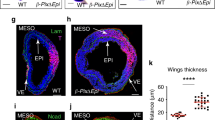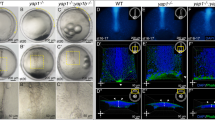Abstract
Vertebrate embryos are characterized by an elongated antero-posterior (AP) body axis, which forms by progressive cell deposition from a posterior growth zone in the embryo. Here, we used tissue ablation in the chicken embryo to demonstrate that the caudal presomitic mesoderm (PSM) has a key role in axis elongation. Using time-lapse microscopy, we analysed the movements of fluorescently labelled cells in the PSM during embryo elongation, which revealed a clear posterior-to-anterior gradient of cell motility and directionality in the PSM. We tracked the movement of the PSM extracellular matrix in parallel with the labelled cells and subtracted the extracellular matrix movement from the global motion of cells. After subtraction, cell motility remained graded but lacked directionality, indicating that the posterior cell movements associated with axis elongation in the PSM are not intrinsic but reflect tissue deformation. The gradient of cell motion along the PSM parallels the fibroblast growth factor (FGF)/mitogen-activated protein kinase (MAPK) gradient1, which has been implicated in the control of cell motility in this tissue2. Both FGF signalling gain- and loss-of-function experiments lead to disruption of the motility gradient and a slowing down of axis elongation. Furthermore, embryos treated with cell movement inhibitors (blebbistatin or RhoK inhibitor), but not cell cycle inhibitors, show a slower axis elongation rate. We propose that the gradient of random cell motility downstream of FGF signalling in the PSM controls posterior elongation in the amniote embryo. Our data indicate that tissue elongation is an emergent property that arises from the collective regulation of graded, random cell motion rather than by the regulation of directionality of individual cellular movements.
This is a preview of subscription content, access via your institution
Access options
Subscribe to this journal
Receive 51 print issues and online access
$199.00 per year
only $3.90 per issue
Buy this article
- Purchase on Springer Link
- Instant access to full article PDF
Prices may be subject to local taxes which are calculated during checkout




Similar content being viewed by others
References
Dubrulle, J. & Pourquie, O. fgf8 mRNA decay establishes a gradient that couples axial elongation to patterning in the vertebrate embryo. Nature 427, 419–422 (2004)
Delfini, M. C., Dubrulle, J., Malapert, P., Chal, J. & Pourquie, O. Control of the segmentation process by graded MAPK/ERK activation in the chick embryo. Proc. Natl Acad. Sci. USA 102, 11343–11348 (2005)
Keller, R., Shook, D. & Skoglund, P. The forces that shape embryos: physical aspects of convergent extension by cell intercalation. Phys. Biol. 5, 015007 (2008)
Lawson, A. & Schoenwolf, G. C. New insights into critical events of avian gastrulation. Anat. Rec. 262, 238–252 (2001)
Voiculescu, O., Bertocchini, F., Wolpert, L., Keller, R. E. & Stern, C. D. The amniote primitive streak is defined by epithelial cell intercalation before gastrulation. Nature 449, 1049–1052 (2007)
Yang, X., Dormann, D., Munsterberg, A. E. & Weijer, C. J. Cell movement patterns during gastrulation in the chick are controlled by positive and negative chemotaxis mediated by FGF4 and FGF8. Dev. Cell 3, 425–437 (2002)
Beddington, R. S. Induction of a second neural axis by the mouse node. Development 120, 613–620 (1994)
Waddington, C. H. Experiments on the development of chick and duck embryos cultivated in vitro. Philos. Trans. R. Soc. Lond. B 221, 179–230 (1932)
Charrier, J. B., Teillet, M. A., Lapointe, F. & Le Douarin, N. M. Defining subregions of Hensen’s node essential for caudalward movement, midline development and cell survival. Development 126, 4771–4783 (1999)
Bellairs, R. The development of somites in the chick embryo. J. Embryol. Exp. Morphol. 11, 697–714 (1963)
Spratt, N. T. Jr. Analysis of the organizer center in the early chick embryo. I. Localisation of prospective notochord and somite cells. J. Exp. Zool. 128, 121–163 (1955)
Hamburger, V. The stage series of the chick embryo. Dev. Dyn. 195, 273–275 (1992)
Martin, P. & Lewis, J. Actin cables and epidermal movement in embryonic wound healing. Nature 360, 179–183 (1992)
Sbalzarini, I. F. & Koumoutsakos, P. Feature point tracking and trajectory analysis for video imaging in cell biology. J. Struct. Biol. 151, 182–195 (2005)
Kulesa, P. M. & Fraser, S. E. Cell dynamics during somite boundary formation revealed by time-lapse analysis. Science 298, 991–995 (2002)
Rifes, P. et al. Redefining the role of ectoderm in somitogenesis: a player in the formation of the fibronectin matrix of presomitic mesoderm. Development 134, 3155–3165 (2007)
Zamir, E. A., Rongish, B. J. & Little, C. D. The ECM moves during primitive streak formation–computation of ECM versus cellular motion. PLoS Biol. 6, e247 (2008)
Zamir, E. A., Czirók, A., Cui, C., Little, C. D. & Rongish, B. J. Mesodermal cell displacements during avian gastrulation are due to both individual cell-autonomous and convective tissue movements. Proc. Natl Acad. Sci. USA 103, 19806–19811 (2006)
Berg, H. C. Random Walks in Biology. (Princeton Univ. Press, 1993)
Czirók, A., Zamir, E. A., Filla, M. B., Little, C. D. & Rongish, B. J. Extracellular matrix macroassembly dynamics in early vertebrate embryos. Curr. Top. Dev. Biol. 73, 237–258 (2006)
Amaya, E., Musci, T. J. & Kirschner, M. W. Expression of a dominant negative mutant of the FGF receptor disrupts mesoderm formation in Xenopus embryos. Cell 66, 257–270 (1991)
Ciruna, B. & Rossant, J. FGF signaling regulates mesoderm cell fate specification and morphogenetic movement at the primitive streak. Dev. Cell 1, 37–49 (2001)
Sun, X., Meyers, E. N., Lewandoski, M. & Martin, G. R. Targeted disruption of Fgf8 causes failure of cell migration in the gastrulating mouse embryo. Genes Dev. 13, 1834–1846 (1999)
Watanabe, T. et al. Tet-on inducible system combined with in ovo electroporation dissects multiple roles of genes in somitogenesis of chicken embryos. Dev. Biol. 305, 625–636 (2007)
Cai, A. Q., Landman, K. A. & Hughes, B. D. Modelling directional guidance and motility regulation in cell migration. Bull. Math. Biol. 68, 25–52 (2006)
Gillespie, D. T. Exact stochastic simulation of coupled chemical reactions. J. Phys. Chem. 81, 2340–2361 (1977)
Chapman, S. C., Collignon, J., Schoenwolf, G. C. & Lumsden, A. Improved method for chick whole-embryo culture using a filter paper carrier. Dev. Dyn. 220, 284–289 (2001)
Czirók, A., Rupp, P. A., Rongish, B. J. & Little, C. D. Multi-field 3D scanning light microscopy of early embryogenesis. J. Microsc. 206, 209–217 (2002)
Rupp, P. A., Rongish, B. J., Czirók, A. & Little, C. D. Culturing of avian embryos for time-lapse imaging. Biotechniques 34, 274–278 (2003)
Araki, I. & Nakamura, H. Engrailed defines the position of dorsal di-mesencephalic boundary by repressing diencephalic fate. Development 126, 5127–5135 (1999)
Acknowledgements
The authors thank R. Li, D. Roellig and members of the Pourquié laboratory for critical reading of the manuscript. The authors acknowledge E. Siggia for support, B. Rongish, M. Filla, C. Cui, A. Peterson, K. Perko, R. Alexander, R. Fender, J. D. Fauny, T. Cheuvront, and members of the IGBMC imaging center for assistance with imaging-related techniques. We thank L. Kennedy and T. Iimura for help with the experiments, and the members of the Cytometry Facility at the Stowers Institute for Medical Research for assistance. We thank S. Leblanc, H. Li, N. Wicker and P. Moncuquet for help with statistical analysis. The authors thank S. Esteban for artwork and J. Chatfield for editorial assistance. This research was supported by the Howard Hughes Medical Institute, the Stowers Institute for Medical Research, NIH grant R02 HD043158 and a Chaire d’excellence to O.P.; P.F. is supported by NSF grant DMR-0129848 (attributed to E. Siggia) and Lavoisier Fellowship. R.E.B. is supported by an RCUK Fellowship in Mathematical Biology and a Microsoft European Postdoctoral Research Fellowship. C.D.L. is supported by the Mathers Charitable Foundation.
Author information
Authors and Affiliations
Contributions
B.B. and O.P. designed the biological experiments. B.B. and N.D. performed the biological experiments. C.D.L. gave technical and theoretical support for the time-lapse experiments. P.F., N.D., B.B. and O.P. analysed the biological experiments; in particular, P.F. designed the tracking programs, tracked cells and ECM motions, and performed the random walk analysis. R.E.B. designed, analysed and simulated the mathematical models in collaboration with B.B., P.F. and O.P.; B.B., O.P., R.E.B. and P.F. wrote the manuscript. All authors discussed the results and commented on the manuscript. O.P. supervised the project.
Corresponding author
Ethics declarations
Competing interests
The authors declare no competing financial interests.
Supplementary information
Supplementary Information
This file contains Supplementary Figures 1-10 with legends, Supplementary Methods and References, Supplementary Notes, which include, numerical simulation, results, data processing, figures 1-2 with legends and statistics, and full legends for Supplementary Movies 1-17. (PDF 3045 kb)
Supplementary Movie 1
Brighfield recording showing the elongation of an embryo in which the caudal PSM was ablated. (MOV 3110 kb)
Supplementary Movie 2
Brighfield recording showing the elongation of an embryo in which the axial caudal progenitor zone was ablated. (MOV 4266 kb)
Supplementary Movie 3
Brighfield recording showing the elongation of an embryo in which the lateral plates were ablated. (MOV 4980 kb)
Supplementary Movie 4
Brighfield recording showing the elongation of embryo in which the rostral PSM progenitor zone was ablated. (MOV 3880 kb)
Supplementary Movie 5
This movie shows cellular movements in the PSM during embryo elongation. (MOV 5357 kb)
Supplementary Movie 6
This movie shows cellular movements and ECM movement in the PSM during embryo elongation. (MOV 5378 kb)
Supplementary Movie 7
This movie shows fibronectin and Fibrillin-2 movement in the PSM during embryo elongation. (MOV 5593 kb)
Supplementary Movie 8
This movie shows the effect of FGFR1dn electroporation on cellular movements and embryo elongation. (MOV 4357 kb)
Supplementary Movie 9
This movie shows the effect of FGF8 electroporation on cellular movements and embryo elongation. (MOV 4357 kb)
Supplementary Movie 10
This movie shows the effect of the Rho-Kinase inhibitor Y27632 on cellular movements and embryo elongation. (MOV 4594 kb)
Supplementary Movie 11
This movie shows effect of Blebbistatin on cellular movements and embryo elongation. (MOV 6880 kb)
Supplementary Movie 12
This movie shows the effect of Mitomycin C on cellular movements and embryo elongation. (MOV 5801 kb)
Supplementary Movie 13
This movie shows the effect of Aphidicolin on cellular movements and embryo elongation. (MOV 6347 kb)
Supplementary Movie 14
This movie file contains an Illustration of directional diffusion. (MOV 4406 kb)
Supplementary Movie 15
This movie shows the mathematical simulation of PSM cellular movements with gradient of cellular motility. (MOV 545 kb)
Supplementary Movie 16
This movie shows the mathematical simulation of PSM cellular movements without gradient of cellular motility. (MOV 555 kb)
Supplementary Movie 17
This movie shows the cellular movements and tissue movement in the PSM during embryo elongation growing on New culture. (MOV 3355 kb)
Rights and permissions
About this article
Cite this article
Bénazéraf, B., Francois, P., Baker, R. et al. A random cell motility gradient downstream of FGF controls elongation of an amniote embryo. Nature 466, 248–252 (2010). https://doi.org/10.1038/nature09151
Received:
Accepted:
Issue Date:
DOI: https://doi.org/10.1038/nature09151
This article is cited by
-
Downregulation of extraembryonic tension controls body axis formation in avian embryos
Nature Communications (2023)
-
Morphogenesis beyond in vivo
Nature Reviews Physics (2023)
-
Mechanics of the cellular microenvironment as probed by cells in vivo during zebrafish presomitic mesoderm differentiation
Nature Materials (2023)
-
Adherens junctions as molecular regulators of emergent tissue mechanics
Nature Reviews Molecular Cell Biology (2023)
-
Sculpting tissues by phase transitions
Nature Communications (2022)
Comments
By submitting a comment you agree to abide by our Terms and Community Guidelines. If you find something abusive or that does not comply with our terms or guidelines please flag it as inappropriate.



